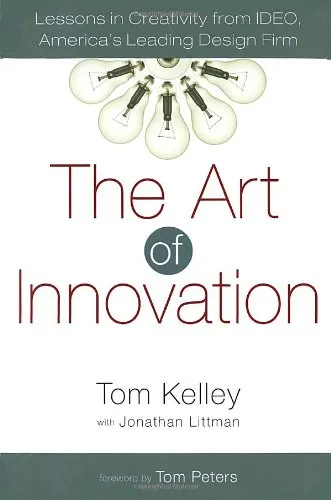The structure of scientific revolutions: 50th anniversary edition
4.5
بر اساس نظر کاربران

شما میتونید سوالاتتون در باره کتاب رو از هوش مصنوعیش بعد از ورود بپرسید
هر دانلود یا پرسش از هوش مصنوعی 2 امتیاز لازم دارد، برای بدست آوردن امتیاز رایگان، به صفحه ی راهنمای امتیازات سر بزنید و یک سری کار ارزشمند انجام بدینکتاب های مرتبط:
معرفی کلی کتاب
کتاب "The Structure of Scientific Revolutions" اثر توماس اس. کوهن یکی از آثار برجستهای است که درک ما از فرآیند علوم و تغییرات آنها را به چالش میکشد و نگاه جدیدی به تحول علمی ارائه میدهد. این کتاب نقطه عطفی در فلسفه علم محسوب میشود و مفاهیم نوآورانهای مانند Paradigm و انقلاب علمی را به تفصیل بررسی میکند.
خلاصهای از محتوای کتاب
این کتاب در چهار بخش اصلی به بررسی تغییرات اساسی در علوم میپردازد. در بخش نخست، کوهن توضیح میدهد که علم معمولاً در چارچوبی از Paradigm های ثابت عمل میکند که این Paradigm ها به شکل یک مدل یا الگوی مسلط کار میکنند. اما در دورههای خاص، این Paradigm ها به چالش کشیده میشوند و راه را برای Paradigm های جدید باز میکنند.
در بخش دوم، به مفهوم بحران پرداخته میشود که در آن محققان با ناکارآمدی Paradigm های موجود مواجه میشوند. در چنین شرایطی، دادههای جدید و یافتههای نامطابق با Paradigm های قبلی، بحران را تشدید میکنند.
بخش سوم به معرفی انقلابهای علمی میپردازد که این انقلابها به معنی تغییرات بنیادین در Paradigm ها هستند. تغییراتی که موجب میشود علم به مسیر جدیدی هدایت شود.
سرانجام، در بخش چهارم، کوهن به تأثیرات این تغییرات بر جوامع علمی و نحوه پذیرش Paradigm های جدید توسط دانشمندان میپردازد.
نکات کلیدی
- تعریف مفهوم Paradigm به عنوان مجموعهای از اصول و قواعدی که پایگاه و چهارچوب تحقیقات علمی را تشکیل میدهند.
- نحوه به وجود آمدن بحران در علوم زمانی که Paradigm جاری قادر به توضیح پدیدههای جدید نیست.
- توصیف فرآیند انقلابهای علمی که طی آن Paradigm جدیدی جای Paradigm قدیم را میگیرد.
- ارتباط میان تغییرات علمی و تغییرات فرهنگی و اجتماعی.
جملات معروف از کتاب
"شاید انقلابهای علمی قابل قیاس با انقلابهای سیاسی باشند، زیرا هر دو در راستای تغییر باورها و ارزشها عمل میکنند."
"تاریخ علم به ما نشان میدهد که دستاوردهای بزرگ علمی حاصل تضاد و تعامل بین Paradigm های متفاوت است."
چرا این کتاب اهمیت دارد
این کتاب به دلیل ارائه دیدگاه تازهای به فرآیند تکامل علوم، تأثیر بسیاری بر جامعه علمی و فلسفی داشته است. کوهن با معرفی مفهوم Paradigm و تحلیل تغییرات انقلابی در علم، نگرش جامعی از چگونگی توسعه و تحول علم به دست میدهد. این نگاه نه تنها به درک تخصصی و آکادمیک کمک میکند بلکه به جامعه وسیعتری که به تحلیل فرآیندهای فکری و تحولاتی که جهان ما را شکل دادهاند، علاقهمند است نیز یاری میرساند.
The Structure of Scientific Revolutions, originally published in 1962 by Thomas S. Kuhn, represents a pivotal shift in the way we understand scientific progress. Its 50th anniversary edition continues to influence readers with its groundbreaking ideas on how scientific knowledge develops and transforms over time.
Detailed Summary of the Book
The central theme of Kuhn's work is the concept of paradigms in science. He argues that scientific advancement does not occur through a linear accumulation of facts but via a series of discontinuous revolutions. According to Kuhn, normal science operates under a prevailing paradigm—a framework of theories, methods, and standards. This paradigm guides research and shapes the interpretation of data until anomalies arise that the current paradigm cannot explain.
These anomalies lead to a crisis that challenges the dominant paradigm. During this period of revolutionary science, new ideas and approaches are explored, eventually culminating in a paradigm shift. This replacement and acceptance of the new paradigm are what Kuhn terms a "scientific revolution." The new paradigm redefines the field, making it incommensurable with the old, and scientists begin to see the world through a new lens.
The book profoundly challenges the notion that science is an objective pursuit of truth. Instead, it highlights the influence of social and cultural factors in scientific progress. Kuhn’s analysis draws from history, philosophy, and sociology, making it a multi-disciplinary examination of the scientific process.
Key Takeaways
- The concept of paradigms and paradigm shifts as central to scientific progress.
- The distinction between normal science and revolutionary science.
- Scientific revolutions lead to changes in worldviews and are not purely objective processes.
- The role of anomalies in prompting scientific change.
- The idea that once a new paradigm is established, previous scientific frameworks become largely incompatible.
Famous Quotes from the Book
"Normal science, the activity in which most scientists inevitably spend almost all their time, is predicated on the assumption that the scientific community knows what the world is like."
"A paradigm is what members of a scientific community share, and, conversely, a scientific community consists of men who share a paradigm."
"Scientific revolutions are inaugurated by a growing sense... that an existing paradigm has ceased to function adequately in the exploration of an aspect of nature to which that paradigm itself had previously led the way."
Why This Book Matters
Kuhn's work fundamentally altered the philosophy of science and the historical understanding of scientific development. By illustrating how scientific consensus shifts and how deeply intertwined scientific practice is with social and historical contexts, Kuhn provided a lens through which to view scientific progress as a dynamic, sometimes unpredictable process. The book’s ideas transcended academia, influencing disciplines as diverse as political science, economics, and sociology.
For anyone seeking to understand the nature of scientific innovation and the factors that drive it, Kuhn’s analysis remains invaluable. The insights laid out in this book continue to prompt reflection on the complexities involved in scientific discovery and challenge the perception of science as an objective and systematic pursuit of truth.
دانلود رایگان مستقیم
شما میتونید سوالاتتون در باره کتاب رو از هوش مصنوعیش بعد از ورود بپرسید
دسترسی به کتابها از طریق پلتفرمهای قانونی و کتابخانههای عمومی نه تنها از حقوق نویسندگان و ناشران حمایت میکند، بلکه به پایداری فرهنگ کتابخوانی نیز کمک میرساند. پیش از دانلود، لحظهای به بررسی این گزینهها فکر کنید.
این کتاب رو در پلتفرم های دیگه ببینید
WorldCat به شما کمک میکنه تا کتاب ها رو در کتابخانه های سراسر دنیا پیدا کنید
امتیازها، نظرات تخصصی و صحبت ها درباره کتاب را در Goodreads ببینید
کتابهای کمیاب یا دست دوم را در AbeBooks پیدا کنید و بخرید
1324
بازدید4.5
امتیاز0
نظر98%
رضایتنظرات:
4.5
بر اساس 0 نظر کاربران
Questions & Answers
Ask questions about this book or help others by answering
No questions yet. Be the first to ask!















